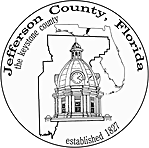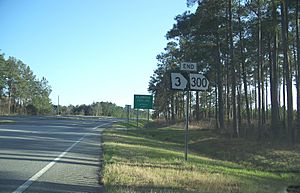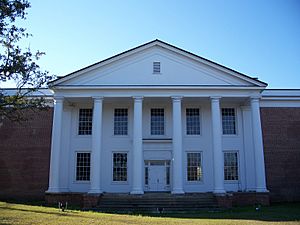Jefferson County, Florida facts for kids
Quick facts for kids
Jefferson County
|
||
|---|---|---|
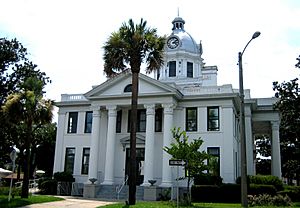
Jefferson County Courthouse in Monticello
|
||
|
||
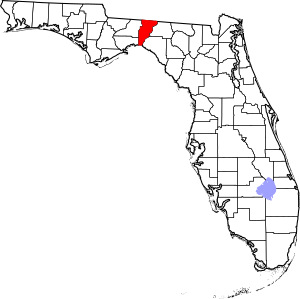
Location within the U.S. state of Florida
|
||
 Florida's location within the U.S. |
||
| Country | ||
| State | ||
| Founded | January 20, 1827 | |
| Named for | Thomas Jefferson | |
| Seat | Monticello | |
| Largest city | Monticello | |
| Area | ||
| • Total | 637 sq mi (1,650 km2) | |
| • Land | 598 sq mi (1,550 km2) | |
| • Water | 38 sq mi (100 km2) 6.0%% | |
| Population
(2020)
|
||
| • Total | 14,510 | |
| • Estimate
(2023)
|
15,450 |
|
| • Density | 22.779/sq mi (8.795/km2) | |
| Time zone | UTC−5 (Eastern) | |
| • Summer (DST) | UTC−4 (EDT) | |
| Congressional district | 2nd | |
Jefferson County is a county in the Big Bend area of northern Florida. In 2020, about 14,510 people lived there. Its main town, or county seat, is Monticello. Jefferson County is part of the Tallahassee area. It is also one of the most rural counties in Florida. You won't find any traffic signals in the whole county!
Contents
History
In the 1700s, a group of Native Americans called the Chiaha settled in this area. They later became part of the Mikasuki-speaking Seminole people.
Jefferson County was created in 1827. It was named after Thomas Jefferson, who was the third president of the United States. He had passed away the year before the county was formed.
Forts of Jefferson County
During early times, several forts were built in Jefferson County:
- Fort Roger Jones (1839), near Aucilla
- Fort Noel (1839–1842), south of Lamont
- Camp Carter (1838), near Waukeenah
- Fort Welaunee (1838), a settlers' fort near Wacissa. Fort Gamble was built here later.
- Fort Aucilla (1843), southwest of Lamont
- Fort Wacissa (1838), a settlers' fort south of Wacissa
Life During the American Civil War
Before the American Civil War, cotton was the main crop grown in Jefferson County. About 17% of all Florida's cotton came from here. Many large farms, called plantations, were in the county. In 1860, 64% of the people living in Jefferson County were Black.
After slavery ended, the Black population in Jefferson County continued to grow. By 1870, 72% of the people were Black. To help the large Black community, the Freedmen's Bureau opened an office in Monticello around 1866.
Geography
Jefferson County covers about 637 square miles. Most of this is land (598 square miles), and 38 square miles (6%) is water.
It is the only county in Florida that touches both the state of Georgia and the Gulf of Mexico.
Neighboring Counties
Jefferson County shares borders with these counties:
- Thomas County, Georgia - to the north
- Brooks County, Georgia - to the northeast
- Madison County - to the east
- Taylor County - to the southeast
- Wakulla County - to the southwest
- Leon County - to the west
Protected Areas
- St. Marks National Wildlife Refuge (part of it is in Jefferson County)
Water Bodies
Important rivers and bodies of water in the county include:
Population Information
| Historical population | |||
|---|---|---|---|
| Census | Pop. | %± | |
| 1830 | 3,312 | — | |
| 1840 | 5,713 | 72.5% | |
| 1850 | 7,718 | 35.1% | |
| 1860 | 9,876 | 28.0% | |
| 1870 | 13,398 | 35.7% | |
| 1880 | 16,065 | 19.9% | |
| 1890 | 15,757 | −1.9% | |
| 1900 | 16,195 | 2.8% | |
| 1910 | 17,210 | 6.3% | |
| 1920 | 14,502 | −15.7% | |
| 1930 | 13,408 | −7.5% | |
| 1940 | 12,032 | −10.3% | |
| 1950 | 10,413 | −13.5% | |
| 1960 | 9,543 | −8.4% | |
| 1970 | 8,778 | −8.0% | |
| 1980 | 10,703 | 21.9% | |
| 1990 | 11,296 | 5.5% | |
| 2000 | 12,902 | 14.2% | |
| 2010 | 14,761 | 14.4% | |
| 2020 | 14,510 | −1.7% | |
| 2023 (est.) | 15,450 | 4.7% | |
| U.S. Decennial Census 1790-1960 1900-1990 1990-2000 2010-2019 |
|||
2020 Census
In 2020, Jefferson County had 14,510 people. There were 5,770 households and 3,761 families living in the county. About 60% of the population was White, and about 31.7% was Black or African American. Around 4.5% of the population was Hispanic or Latino.
2010 Census
In 2010, the county had 14,761 people. There were 5,646 households and 3,798 families. The population density was about 25 people per square mile. About 60.4% of the people were White, and 36.2% were Black or African American. About 3.7% of the population was Hispanic or Latino.
The average household had 2.38 people, and the average family had 2.89 people. About 18.6% of the population was under 18 years old.
Education
The Jefferson County Schools district runs the public schools. This includes Jefferson County Middle / High School. There is also a private school called Aucilla Christian Academy.
Library
The public library in Jefferson County is called the R.J. Bailar Public Library. It is part of the Wilderness Coast Public Libraries Cooperative. The library is located in the building that used to be the old Jefferson High School library.
Transportation
Railroads
A CSX railroad line runs through the county. This line was once used by Amtrak's Sunset Limited train until 2005. No Amtrak trains stop in Jefferson County anymore.
Main Highways
Many important roads cross Jefferson County:
 I-10 (Interstate 10) is the main highway going from west to east. It has three exits in the county.
I-10 (Interstate 10) is the main highway going from west to east. It has three exits in the county. US 19 is a major road going north and south. It passes through Monticello and has a traffic circle with US 90 around the historic courthouse.
US 19 is a major road going north and south. It passes through Monticello and has a traffic circle with US 90 around the historic courthouse. US 27 is another north-south highway. It splits off from US 19 in Capps and heads west towards Tallahassee.
US 27 is another north-south highway. It splits off from US 19 in Capps and heads west towards Tallahassee. SR 59 connects US 90 to US 98.
SR 59 connects US 90 to US 98. US 90 used to be the main west-to-east highway before I-10. It goes through Monticello and crosses the Aucilla River.
US 90 used to be the main west-to-east highway before I-10. It goes through Monticello and crosses the Aucilla River. US 98 is the southernmost east-west road. It runs through conservation areas near the Gulf of Mexico.
US 98 is the southernmost east-west road. It runs through conservation areas near the Gulf of Mexico. US 221 is the easternmost US highway. It runs through the northeastern part of the county, including Ashville.
US 221 is the easternmost US highway. It runs through the northeastern part of the county, including Ashville. CR 259 is a two-lane road called Waukeenah Highway. It runs from the Leon County line through Wacissa.
CR 259 is a two-lane road called Waukeenah Highway. It runs from the Leon County line through Wacissa.
Communities
City
Census-designated places
These are areas that are like towns but are not officially incorporated as cities:
Other Communities
- Alma
- Ashville
- Capps
- Casa Blanco
- Cody
- Dills
- Drifton
- Fanlew
- Festus
- Fincher
- Jarrott
- Limestone
- Lois
- Montivilla
- Nash
- Thomas City
See also
 In Spanish: Condado de Jefferson (Florida) para niños
In Spanish: Condado de Jefferson (Florida) para niños


